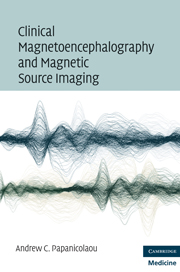Book contents
- Frontmatter
- Contents
- Contributors
- Preface
- Section 1 The method
- 1 Basic concepts
- 2 The nature and origin of magnetic signals
- 3 Recording the magnetic flux
- 4 Overview of MSI using the single equivalent current dipole (ECD) model as an example
- 5 The fundamental problems of MSI
- 6 Head models
- 7 Source models – discrete source models
- 8 Source models – distributed source models
- 9 Source models – beamformers
- 10 Pragmatic features of the clinical use of MEG/MSI
- Section 2 Spontaneous brain activity
- Section 3 Evoked magnetic fields
- Postscript: Future applications of clinical MEG
- References
- Index
4 - Overview of MSI using the single equivalent current dipole (ECD) model as an example
from Section 1 - The method
Published online by Cambridge University Press: 01 March 2010
- Frontmatter
- Contents
- Contributors
- Preface
- Section 1 The method
- 1 Basic concepts
- 2 The nature and origin of magnetic signals
- 3 Recording the magnetic flux
- 4 Overview of MSI using the single equivalent current dipole (ECD) model as an example
- 5 The fundamental problems of MSI
- 6 Head models
- 7 Source models – discrete source models
- 8 Source models – distributed source models
- 9 Source models – beamformers
- 10 Pragmatic features of the clinical use of MEG/MSI
- Section 2 Spontaneous brain activity
- Section 3 Evoked magnetic fields
- Postscript: Future applications of clinical MEG
- References
- Index
Summary
Based on the characteristics of good dipolar distributions obtained with magnetometers and axial gradiometers, we can estimate some of the attributes of the source inside the brain: (1) the source must be below the midpoint between the extrema; (2) the source must be at a depth proportional to the distance between the extrema, i.e., a source close to the surface of the brain produces extrema that are close together, while a deeper source produces extrema that are farther apart; (3) for a given depth, the strength of the source would be reflected in the absolute intensity of the flux recorded; and (4) the orientation of the source is reflected in the relative orientation of the extrema on the head surface.
In general, when a physical phenomenon is regulated by known laws and one knows the causes of the phenomenon, one can predict the phenomenon uniquely. Calculating an effect – or predicting a phenomenon – from a set of known causes or antecedent conditions is called the solution of the “forward problem.” The more precise the knowledge of the antecedent conditions, the more accurately their effect can be calculated. With no uncertainty about the validity of the solution, the solution is unique.
The relation of the characteristics of intracranial currents (the cause) to the magnetic distribution that such a source would produce on a particular surface (the effect) is specified by the Biot–Savart Law for a dipole in free space.
- Type
- Chapter
- Information
- Publisher: Cambridge University PressPrint publication year: 2009



